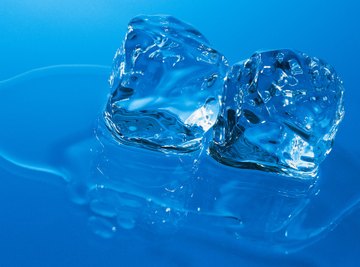
The rate at which ice cubes melt, also called their fusion rate, depends on several factors. Higher environmental temperatures speed the melting process. The color of the cube and the application of salt have noticeable effects. The fusion rate also varies with the shape of the ice cube.
Surface Area
Ice melts when a warmer medium, such as air or water at room temperature, comes into contact with its surface. For this reason, ice melts faster when its exposed surface area is maximized. So ice cube shapes with greater surface areas melt faster.
Volume and Temperature
In order to determine with accuracy what ice cube shapes melt faster, all the ice cubes in the test must have the same volume. If one ice cube has a greater amount of ice, it melts more slowly because of the added mass. Moreover, all ice cubes must have the same temperature at the time the test begins. If an ice cube has a temperature considerably below the freezing point of water, it melts more slowly because of the time that elapses before its temperature reaches the melting point.
Sphere, Cylinder or Cube
Suppose that an ice cube has the shape of a cube. If each side of the ice cube measures three centimeters, then it has a volume of 27 cc and a surface area of 54 square centimeters. Suppose that another ice cube has the shape of a circular cylinder. If it also has a volume of 27 cc and if its diameter roughly equals its height, it has a surface area of approximately 50 square centimeters. A spherical ice cube with the same volume has a surface area of approximately 43.5 square centimeters. Therefore, the cubical ice cube melts faster than either of the other two shapes since it has the greatest surface area.
Fastest-Melting Ice Cube
If you make a cylindrical ice cube that is taller and thinner while retaining its 27 cc volume, its surface area increases. If you reduce the width and the height of a cubical ice cube so that it becomes a box-like structure known as a rectangular parallelepiped, its surface area also increases. The more the surface area increases, the faster the ice cube melts, provided that the volume remains unchanged. As the parallelepiped and the circular cylinder get longer, their surface area values gradually approximate each other. Theoretically, the fastest melting ice cube has the shape of a parallelepiped that has the height of one water molecule and the width of one water molecule, while its length consists of all the water molecules strung out in a straight line. At the same time, this theoretical ice cube also has the shape of an extremely long circular cylinder with a diameter of one water molecule.
References
- Calculator Free Online: Sphere Calculator
- Calculator Free Online: Circular Cylinder Calculator
- Math: Surface Area Formulas
- Jordan Worrell 1: Does and Ice Cube Melt Faster When it is Crushed or Whole?
- Liquid Boutique: More Than You Ever Wanted to Know about Ice
- "Serway's College Physics"; Jerry S. Faughn, Raymond Serway, Chris Vuille and Charles A. Bennett; 2006
Photo Credits
Comstock/Comstock/Getty Images
